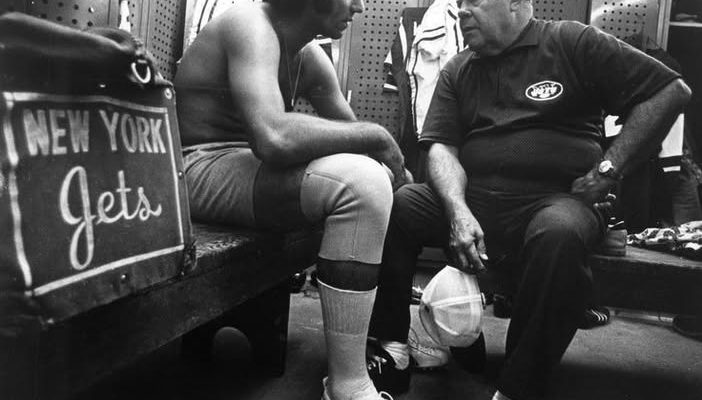The black-and-white photograph of Joe Namath and Weeb Ewbank in the New York Jets locker room remains one of the most iconic images in NFL history. It freezes time, preserving not just two men, but a moment that would forever shift the power dynamic of professional football. Taken during the 1968-1969 season, this image is layered with meaning—an unspoken synergy between coach and quarterback, a sense of strategy and confidence, a visual embodiment of belief that would soon translate into one of the most historic upsets in sports history. That moment, tucked into a quiet corner of the locker room, was a prelude to glory. A close examination reveals more than what’s captured on the surface—it’s a testament to vision, trust, and transformation.
Joe Namath, often referred to as “Broadway Joe,” was not your conventional quarterback. Known for his brash confidence, Hollywood looks, and gunslinger mentality, Namath brought charisma and swagger to a league that was still trying to find its media identity. He played with style both on and off the field. From his fur coats to nightclub appearances, Namath was every bit the New York star, but he was also deeply committed to his teammates and to winning. At the core of his confidence was a fierce competitive fire and an unmatched belief in himself—traits that Weeb Ewbank recognized early and knew how to cultivate without trying to suppress.
Weeb Ewbank, by contrast, was a stoic, methodical presence. Already a championship-winning coach with the Baltimore Colts, Ewbank brought wisdom, patience, and a teacher’s demeanor to the Jets’ locker room. His career had spanned decades, and his understanding of both Xs and Os and locker room dynamics set him apart from his contemporaries. Unlike coaches who preferred to impose their systems onto players, Ewbank adapted his approach to fit the talents of his roster. In Joe Namath, Ewbank saw not just talent, but potential greatness—raw and unfiltered. He didn’t try to tame Namath; he refined him.
When the Jets selected Namath first overall in the 1965 AFL Draft, it was a bold and expensive move. Namath’s \$427,000 contract was the richest in pro football history at the time, a signal that the Jets were willing to bank on a young, brash quarterback from Alabama to carry the fledgling franchise. The American Football League was still fighting for legitimacy against the older, more established NFL. Namath wasn’t just a quarterback—he was the AFL’s standard-bearer, a player whose talent and personality could draw crowds, ratings, and credibility.
The image in the locker room could have been taken before or after any number of games, but its timing and aura suggest something greater. Perhaps it was snapped after the Jets won the AFL Championship against the Oakland Raiders, a tight 27-23 contest that punched their ticket to Super Bowl III. Or maybe it came in the calm before the storm, a quiet moment of alignment before taking on the seemingly invincible Baltimore Colts, Ewbank’s former team and the NFL’s pride. Either way, the image captures an essence—Namath, helmet off, eyes focused, and Ewbank, calm and deliberate, speaking softly but intently.
The context around that Super Bowl is crucial. The Baltimore Colts were 13-1 in the regular season, had destroyed the Cleveland Browns in the NFL Championship, and were viewed as superior in almost every aspect of the game. Most pundits predicted a blowout. Many NFL loyalists viewed the AFL as second-tier, a place for undersized or overlooked talent. The Jets, as AFL champions, were 18-point underdogs. The disparity wasn’t just athletic—it was cultural. The Colts represented the NFL’s conservative, traditional power structure, while the Jets represented the upstart, unproven challengers from the rival league.
It was in that atmosphere that Namath made his now-legendary guarantee: “We’re gonna win the game. I guarantee it.” That statement, made days before the game, sent shockwaves through the sports world. Some took it as a publicity stunt. Others saw it as the delusional confidence of a quarterback in over his head. But those within the Jets locker room, including Ewbank, didn’t blink. They believed in Namath—and more importantly, Namath believed in himself and his team.
Super Bowl III, played on January 12, 1969, was a turning point not only for the Jets but for the entire NFL landscape. Namath’s performance wasn’t gaudy—he didn’t throw a touchdown pass—but it was clinical, efficient, and commanding. He controlled the tempo, audibled brilliantly, and led the Jets on long, sustained drives. The Jets’ defense intercepted Colts quarterback Earl Morrall three times in the first half. The Jets won 16-7, and Namath was named MVP. The image of Namath running off the field with his index finger raised in triumph is etched in NFL lore, but the quieter moment in the locker room with Ewbank carries just as much weight.
It was in the locker room that belief was solidified. Weeb Ewbank knew how to manage personalities. He never tried to curb Namath’s flair—he embraced it. He understood that Namath’s confidence was not a liability but a strategic weapon. When the cameras were off and the press wasn’t around, Ewbank and Namath had a rapport that was based on mutual respect and honesty. That trust enabled Namath to play freely, without fear of reprimand, and allowed Ewbank to lead without dictating.
Their partnership also reflected a deeper evolution in the sport. Ewbank’s ability to pivot from a traditional NFL background to the more modern, media-savvy world of the AFL—and later the unified NFL—speaks volumes about his adaptability. He wasn’t just a coach; he was a builder of football cultures. Namath, meanwhile, became the face of player empowerment. He played his way, talked his way, and lived his way—and he won doing it.
The image of the two men together encapsulates all of that. It is a moment of stillness before the storm, a shared confidence between master and protégé, between general and field commander. It speaks to the layered complexity of football—not just as a game of brute force or flashy statistics but as a game of relationships, belief systems, and timing. Namath needed someone to believe in him without reservation, and Ewbank provided that. Ewbank needed someone to deliver his vision on the field, and Namath answered the call.
After Super Bowl III, the landscape of professional football changed forever. The AFL was no longer considered the inferior league, and the merger between the AFL and NFL gained legitimacy and momentum. The Jets’ victory shattered preconceived notions and opened the door for future stars from every corner of the country to believe they could lead a team to glory, regardless of the league, background, or style.
Weeb Ewbank remains the only coach in football history to win championships in both the NFL and AFL. His name might not get mentioned as often as the Lombardis or Shulas of the world, but his legacy is indelible. He built two champions in two different eras, led by two very different quarterbacks—Johnny Unitas and Joe Namath—each brilliant in their own way. Ewbank understood what each team needed and adapted accordingly.
Namath, for his part, became more than just a football player. He became a cultural icon. He ushered in the modern quarterback era—a blend of athleticism, media awareness, and fearless leadership. He would go on to play several more seasons, but nothing would ever top the perfection of that January afternoon and the moments surrounding it.
The photograph of Namath and Ewbank in the locker room doesn’t need color or context to tell its story, but understanding the layers behind it only adds to its gravity. It’s more than a snapshot; it’s a silent crescendo in the symphony of football history. In that image is the soul of a team, the quiet conviction before an improbable triumph, and the lasting bond between a coach and his quarterback.
Years may pass, players may come and go, but that image will always hold its place in the pantheon of football. It is a reminder that greatness isn’t always loud or adorned in spotlight. Sometimes, it’s found in the quiet moments, in a glance, a word, a nod—between two men who believed in each other, and through that belief, changed the game forever.



